
Droseraceae is a family of carnivorous flowering plants, also known as the sundew family. It consists of approximately 180 species in three extant genera, the vast majority being in the sundew genus Drosera. The family also contains the well-known Venus flytrap and the more obscure waterwheel plant, both of which are the only living species of their respective genera. Representatives of the Droseraceae are found on all continents except Antarctica.

Aldrovanda vesiculosa, commonly known as the waterwheel plant, is the sole extant species in the flowering plant genus Aldrovanda of the family Droseraceae. The plant captures small aquatic invertebrates using traps similar to those of the Venus flytrap. The traps are arranged in whorls around a central, free-floating stem, giving rise to the common name. This is one of the few plant species capable of rapid movement.

Aldrovanda is a genus of carnivorous plants encompassing one extant species and numerous extinct taxa. The genus is named in honor of the Italian naturalist Ulisse Aldrovandi, the founder of the Botanical Garden of Bologna, Orto Botanico dell'Università di Bologna. Aldrovanda vesiculosa has been reported from scattered locations in Europe, Asia, Africa, and Australia.

Peziza is a large genus of saprophytic cup fungi that grow on the ground, rotting wood, or dung. Most members of this genus are of unknown edibility and are difficult to identify as separate species without use of microscopy. The polyphyletic genus has been estimated to contain over 100 species.

Lepechinia is a genus of plants in the mint family, Lamiaceae. It includes several species of plants known commonly as pitchersages. Plants of this genus can be found in Central and South America, Mexico, California, Hispaniola, and Hawaii, although the species in Hawaii is probably a human introduction. Many of them bear attractive pitcher-shaped flowers, often in shades of purple. The genus was named for the Russian botanist Ivan Ivanovich Lepechin. In 2011, the two monotypic genera Chaunostoma and Neoeplingia were shown to be part of Lepechinia.

Pycnodonte is a genus of extinct oysters, fossil marine bivalve mollusks in the family Gryphaeidae, the foam oysters or honeycomb oysters. Shells of species in this genus are found around the world in fossil shell beds from the Valanginian to the Early Pleistocene. They are a commonly found fossil in Cretaceous shellbeds of the Navesink Formation in New Jersey.

Myopa buccata is a species of fly from the genus Myopa in the family Conopidae. Their larvae are endoparasites of bumble bees of the genus Bombus. It is common throughout much of Europe.

Myopa is a genus of flies from the family Conopidae.
M. fenestrata may refer to:
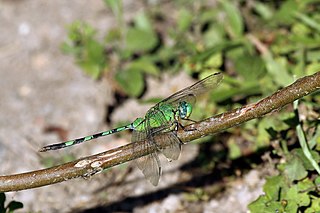
Erythemis vesiculosa, the great pondhawk, is a dragonfly of the family Libellulidae. It is distributed throughout the Americas as far north as the United States.

Myopa dorsalis is a species belonging to the family Conopidae subfamily Myopinae.
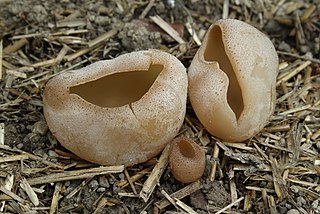
Peziza vesiculosa, commonly known as the common dung cup, is a species of apothecial fungus belonging to the family Pezizaceae.
Meotipa vesiculosa is a species of cobweb spider in the family Theridiidae. It is found in Japan, China, Taiwan, Vietnam, Philippines, and Indonesia. It was described by Eugène Simon in 1895.
Vermilacinia vesiculosa is a fruticose lichen known only from a vertical rock face north of Punta Canoas along the Pacific Coast of Baja California. The epithet vesiculosa is in reference to the bladder-like swellings on the thallus.

Eucalyptus vesiculosa, commonly known as the Corackerup marlock, is a species of marlock that is endemic to a small area on the south coast of Western Australia. It has smooth bark, elliptical to egg-shaped leaves, flower buds usually in groups of seven, red flowers and conical fruit.
Meotipa is a genus of comb-footed spiders that was first described by Eugène Louis Simon in 1895.
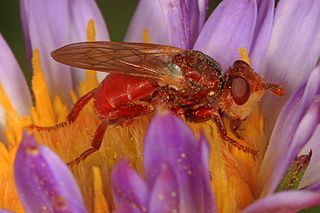
Myopa rubida is a species of thick-headed flies in the family Conopidae.
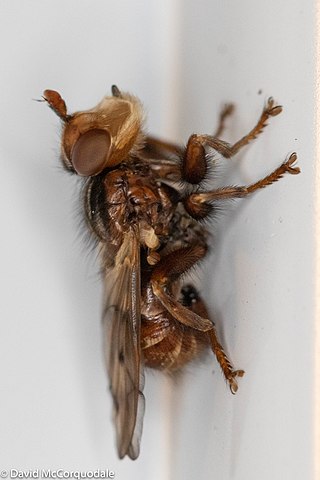
Myopa vicaria is a species of thick-headed flies in the family Conopidae.
Pholeomyia is a genus of freeloader flies in the family Milichiidae. There are more than 30 described species in Pholeomyia.
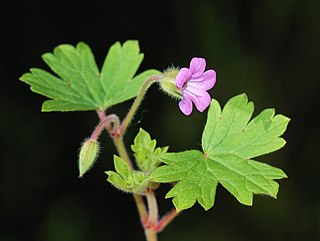
Geranium rotundifolium, is a species of annual herb in the family Geraniaceae. It is native in temperate climates across much of Europe, northern Africa, and southwestern Asia; its distribution is spreading north, in response to global warming. The species favours dry, sandy or stony habitat, including old walls, rail ballast, and building rubble, including in urban areas.














